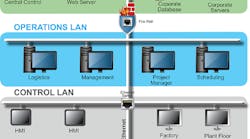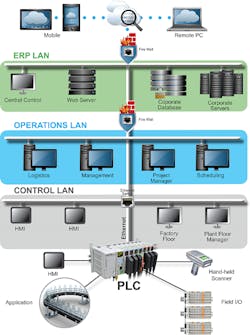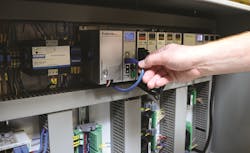Ethernet vs. fieldbus: the right network for the right application
Industrial Ethernet continues to grow, but don’t count out fieldbus networks just yet. The upgrade from 4-20 mA analog signals to fieldbus had a significant impact on industry, but Ethernet networks are positioned to support time-sensitive networking (TSN).
Ethernet’s steady march over the decades has found its way into protocols such as Profinet, PowerLink, EtherCAT and EtherNet/IP. Still, it accounts for less than 40% of market share, according to 2016 research from HMS Industrial Networks.
The fieldbus foothold remains strong at 58% of the market with an annual growth rate of 7%, thanks largely to Profibus’ dominance with 17% market share. Ethernet’s 20% annual growth, however, has continued its rapid expansion. But what are the major differences between Ethernet networks and fieldbus networks? Which protocols run where? And ultimately how do they affect the Industrial Internet of Things (IIoT) and TSN?
What’s the difference?
The major differentiation has focused on deterministic hard real-time performance for manufacturing and machine-building applications in discrete automation, explains Tom Burke, president of OPC Foundation. “Safety and security have been very important, and by definition the industrial fieldbus device networks have done a superior job building deterministic reliable real-time solutions,” he says. “The associations that represent the different fieldbus networks guarantee interoperability as their members who develop products for the respective technology certify their implementations of the standards and often use certified chipsets.”
The beauty of commercial off-the-shelf Ethernet allows any vendor to develop devices that can interact and communicate over the Ethernet, continues Burke. “The world is going to change with the deployment of TSN, given the focus on deterministic high-speed 50 GB real-time operation,” he says. “Clearly, you're going to see all the fieldbus networks scrambling to address and support the TSN networks for their respective networking technology. I expect things like the safety protocol and reliability protocols of the respective organizations to be migrated to the TSN technology, so there still will be somewhat of a differentiation between the industrial networking alternatives and the commercial off-the-shelf TSN Ethernet solution.”
The majority of the industrial fieldbus networks claim connectivity of standard Ethernet devices on the network with the same deterministic operation, says Burke. “But the reality is the majority of the manufacturing operations always segregate the networks, having their standard Ethernet devices running on commercial off-the-shelf Ethernet and then having their fieldbus networking devices running on the fieldbus network, sometimes having a simple bridge or gateway between the two network connections,” he explains.
“One significant difference between fieldbus networks and Ethernet networks is speed, as in most cases Ethernet networks will be faster despite the additional overhead,” explains Ian Verhappen, senior project manager, automation, CIMA+. “Part of the reason for this is that fieldbus systems were designed for the typically noisy plant environment, and as a result speed needed to be slower and of course a suitable physical media found, especially for those protocols in which data and power are in the same single cable.”
Many end devices don’t support Ethernet, says Verhappen. “They don’t need the bandwidth and do need the ability to have power and signal in the same cable,” he explains. “I foresee a need for fieldbuses as a critical element of IIoT and beyond. Unfortunately, PoE doesn’t have the same voltage and power levels as field systems but certainly is useful to remotely power a switch or IP-based device such as a camera or a small controller on a process skid.”
Ethernet still has the distance challenge from the hub. “In many facilities, the processing facilities are greater than this distance from even the distributed I/O or interface room,” says Verhappen. “This means having to build an infrastructure to within reasonable limits of the process, which isn’t difficult but is another step that fieldbus systems can avoid.” Both systems have the advantage for modular systems. “Each module can be fully tested independent of the full facility and then connected to the balance of plant by a single communication cable—Ethernet or fieldbus multiconductor—connection.”
Design and use differences
The most obvious difference between fieldbus networks and Ethernet networks is the design intent, explains Talon Petty, marketing and business development manager, FieldComm Group. Most process applications don’t require high-speed communications. “Ethernet is a collision-based network, meaning it uses high speed to get data through in a timely manner,” he says. “If data-packet collisions occur, it just simply retries until it goes through. Because of the high bandwidth, collisions are typically not a concern for applications such as office Wi-Fi. In process, these collisions, depending on the severity, could have a major impact. The same is true with discrete systems such as assembly lines. These networks just need to repeat the same action over and over. In process, it is a constantly varying data network. Temperatures have to go up and down, and valves must fluctuate flow rates. It’s, by definition, a process. These processes also don’t require the high-speed capabilities of Ethernet. We’re bytes of data at a time, and we’re talking about processes that can have tolerances for updates in seconds and tens of seconds, even minutes for tank farms. Updates in the millisecond range are not necessary.”
Process skids are especially beneficial with Foundation Fieldbus (FF) because all the wiring and setup can be done at the factory and then the homerun wire simply landed when delivered on-site, says Petty. “It doesn’t get much simpler than that,” he notes. “GE currently does skid implementation on its gas and steam turbines. In fact, 61% of GE’s steam turbines use FF as the control bus, and 35% of gas turbines are delivered with FF. These numbers are 10 to 30 times more than Profibus and CANbus on those systems.”
In manufacturing, device or fieldbus networks such as DeviceNet have typically been applied in control systems at the production site, whether that is a factory floor or a process plant, explains Katherine Voss, president and executive director of ODVA. “Usually connected to a PLC or DCS, these systems have been islands of automation that typify what has been referenced in current literature as ‘Industry 3.0,’” she says. “Although EtherNet/IP has also been applied in islands of automation, EtherNet/IP specifically differentiates itself from device or fieldbus networks because it can be and is used as a bridge to connect these islands. It is also used as a gateway to connect automation systems to supervisory systems, the enterprise and/or the cloud (Figure 1). The objects, services and profiles that can be supported in an EtherNet/IP network are significantly richer than traditional device or fieldbus networks because of the large data packets and architectural variants that are possible. An example of this is cybersecurity through which Ethernet can allow for more robust encryption methods than a network with a smaller data packet size such as DeviceNet.”
Figure 1: EtherNet/IP specifically differentiates itself from device or fieldbus networks because it can be and is used as a bridge to connect islands. It is also used as a gateway to connect automation systems to supervisory systems, the enterprise and/or the cloud.
(Source: AutomationDirect)
In manufacturing, assembly and conveyance systems, device or fieldbus networks can have advantages, particularly as it relates to ease of installation, system configuration and power on the network for use by devices, explains Voss.
Profinet network diagnostics leverage Ethernet protocols, such as HTTP, SNMP and LLDP, that are familiar to the IT staff, says Michael Bowne, executive director, Profibus & Profinet North America (PI NA). For hypertext transfer protocol (HTTP), “PLCs and other controllers often have a Web server built-in, so you can configure them and access information,” says Bowne. “Similarly, managed Ethernet switches, drives, wireless access points and other devices provide a Web interface, as well.”
Simple network management protocol (SNMP) provides information about Ethernet networks by accessing data in Ethernet switches—stand-alone switches or those built into Profinet devices. “Is this port sending and receiving data?” asks Bowne. “Are there lots of retries on that port? SNMP can tell you, so you can act before production is impacted or quickly recover if the line does go down.”
Link layer discovery protocol (LLDP) checks on network neighbors, explains Bowne. “It exchanges messages with the device on the other end of the wire and stores that data. That data can be accessed using standard IT tools and special-purpose industrial tools to determine the network topology. It also can alarm if a link goes down. LLDP is required in Profinet devices,” says Bowne.
“Industrial Ethernet networks like Profinet are faster with larger address spaces and greater bandwidth than serial fieldbuses,” explains Bowne. “Profinet particularly adds network diagnostic capability from the IT world to the already-comprehensive device diagnostics of Profibus. Profinet, like Profibus before it, provides diagnostic data if a device fails, a module in a device fails or a channel on a module is broken. For example, a channel failure could be ‘broken wire’ for a digital output.”
Industrial Ethernet as a fieldbus provides many advantages from a commercial and technological perspective, says Joey Stubbs, P.E., North American representative, EtherCAT Technology Group. “Because the innovation, available products and high performance of Ethernet, unlike legacy fieldbuses, is driven by the much larger consumer electronics and IT markets, this keeps the price of Ethernet-based devices low, while the interoperability and performance remain high,” he explains. “This is key for keeping protocols open and hardware interoperable, not to mention lowering the price of PC-based controllers and interface devices.”
Fresh investment
From a user-centric perspective, the pool of talent available that knows Ethernet is far larger than the pool of talent that understands fieldbus, says Paul Brooks, business development manager at Rockwell Automation. “The tools available make EtherNet/IP far easier to deploy and use than fieldbus technologies,” he explains. “The ability to standardize on a single technology has a significant reduction in total cost of ownership (TCO). There are many operational reasons that the TCO of an Ethernet infrastructure lowers the cost over fieldbus.”
From a vendor perspective, the amount of investment that goes into developing Ethernet and IP-centric technologies is massive compared to what’s available in the fieldbus technologies, continues Brooks. “Inherently, Ethernet and fieldbus have many security challenges in common,” he admits. “We’re able to talk about a whole suite of tools developed for Ethernet that will never be in place with fieldbus. Being a global ubiquitous technology, we’re able to focus on the things no one else is doing.”
Cost difference between Ethernet and fieldbus is a major factor to be considered, says Sloan Zupan, senior product manager, Mitsubishi Electric Automation. “Fieldbus networks typically require an additional network interface card whereas Ethernet is typically built into the CPU itself, so no additional hardware is required,” he explains. “With that being said, there are many more field devices already in the market that support fieldbus networks. These devices typically connect to a block, which provides support for Ethernet connectivity. Once on Ethernet, customers enjoy using standard Cat. 5E cable with Ethernet RJ45 connectors. The speed of Ethernet provides value over fieldbus networks. However, fieldbus networks are often considered to be more reliable than nondeterministic Ethernet solutions.”
The primary differentiators between device/fieldbus networks and Ethernet networks are speed and stable and common physical layer, explains John Wozniak, P.E., automation networking specialist, CC-Link Partner Association (CLPA). “Device/fieldbus networks have multiple physical layers, between RS-485, CAN and RS-232, for example,” he says. “All Ethernet networks, on the other hand, rely only on the same Ethernet physical layer, all based on the IEEE standard 802.3. Even though some are older and slower 802.3c—10 Mbps—or newer and faster 802.3ab—1 Gbit/s—they all have the capability to operate with the same Cat. 5e cable, making it easier for end users to implement Ethernet.”
With the upcoming Industry 4.0/IIoT and the increasing demand for more and more information, the use of device/fieldbus networks is becoming the bottleneck for today’s automation applications, says Wozniak. “With speeds topping off at 10–12 Mbps, some of today’s most popular device/fieldbus networks just are not able to handle the flood of information desired by end users,” he explains. “Even some of today’s Ethernet networks at speeds of 100 Mbps are having difficulty keeping up with today’s tsunami of information. One of the downsides of Industrial Ethernet is the lack of intrinsic deterministic behavioral control with a majority of the Ethernet implementations. Most of the Industrial Ethernet implementations rely on TCP/IP, UDP/IP, for media access. While this collision-based approach is all well and good for general office and home use, it was not really designed for use in an industrial environment, which requires deterministic control.”
Dipl. Ing. André Hennecke, researcher at DFKI, a research center in Kaiserslautern, Germany, provides a list of Ethernet’s advantages over fieldbus. They include:
- supporting the vertical integration (interoperable on all levels and to the IT networks)
- future safety and protection of investment (until now, real-time fieldbus solutions are bought by changes on Layer 2, which leads to incompatible communication; also new Ethernet evolutions, such as 400 Gb/s, which are mainly driven by IT, can also be used)
- reducing costs (specialized network components are more cost-intensive than standard IT components)
- access to higher bandwidth—1,000 Mbs/s up to 10 Gb/s, instead of 100 Mbs— together with full duplex communication.
“Ethernet permits multiple protocols to run over the same network,” says Bill Dehner, technical marketer, AutomationDirect. Setting up an Ethernet network is typically less expensive and easier to configure than with fieldbus protocols, he says (Figure 2).
Figure 2: Setting up an Ethernet network is typically less expensive and easier to configure than with fieldbus protocols.
(Source: AutomationDirect)
Ubiquitous Ethernet
“Ethernet technology has proven incredibly successful and is a near ubiquitous method of communication in the IT world,” says Markus Plankensteiner, vice president, sales industrial, North America, and global alliance manager, TTTech Computertechnik. “It’s a very well standardized and open technology that is easily accessible to everyone, provides a wide range of bandwidth and physical layer options and has significant support in a diverse range of application areas. Up until now, there has been no real-time support in IEEE standardized Ethernet, leading to a number of proprietary modifications of Ethernet being used in industrial and transportation systems where real-time communication is a critical requirement. These solutions have typically been developed for specific tasks or domains. Profinet, EtherCAT and Ethernet/IP compete for recognition in industrial automation. While these protocols perform their specialized tasks capably, they have limits, when it comes to combining with standard Ethernet networks and devices. Deterministic Ethernet, with its real-time functionality, is able to fulfill these specialized requirements while also offering all of the advantages of being an open IEEE standard.”
Ethernet really is ubiquitous, which has created undeniable momentum. “With this level of inertia, we can be completely confident that there will be Ethernet in our near and even distant future,” says Doug Taylor, principal engineer, Concept Systems, a system integrator in Albany, Oregon. “Furthermore, the available knowledge base on Ethernet is galactic. If there are 10 networks being installed in industry, I would wager that nine or more of them are Ethernet, so it pays to be on the bandwagon, even if a fieldbus offers significant specific advantages. Selecting a fieldbus that is not based upon Ethernet puts the designer in the unenviable position of having to defend the choice to management, especially if there are downtime events being blamed on it. With Ethernet’s current bandwidth, liberal constraints and industry acceptance, it presents a near fait accompli to designers as the medium of choice for their networks.”
Where does this bus go?
“While both Profibus and Profinet are highly deterministic networks, Profinet comes with all of the extras associated with being Industrial Ethernet,” says PI NA’s Bowne. “Profinet provides deterministic cycle times for all speed requirements using two techniques: real-time (RT) and isochronous real-time (IRT). RT can provide update times down to 250 microseconds; IRT can provide update times down to 31.25 microseconds while synchronizing all devices on its network.”
When time-sensitive networking is available, Profinet will take advantage of it, says Bowne. “TSN is after all an update to standard Ethernet that Profinet uses for RT communications,” he says. “TSN impacts layers 1 and 2 of the ISO/OSI reference model for networks. Layer 7, the application layer, is unaffected. Web browsing, email and Profinet are all Layer 7 applications.”
Profibus and Profinet International (PI) currently has working groups investigating how best to rely on TSN and other Ethernet evolutions, such as Gigabit and IPv6. “Profinet has the advantage that high-speed and determinism are already available and have been for a long time,” says Bowne. “Profinet is an ideal fit in Industry 4.0 and Industrial Internet of Things infrastructures. It provides the data needed for collection and then analysis. After that analysis, Profinet provides the data path back to the system in order to improve processes. It gives the ability to organize that data into application profiles, or objects, for specific types of devices and applications, simplifying configuration, programming and transparency.”
Profinet diagnostics help manufacturers to avoid downtime, says Bowne. “It’s all based on open standards, even down to the means of integrating serial fieldbuses like Profibus and DeviceNet into Profinet,” he explains.
DeviceNet, like EtherNet/IP, utilizes a producer-consumer approach to network communication, explains ODVA’s Voss. “This approach improves network efficiency, and thus performance, by helping to optimize the amount of message traffic on the network,” she says. “DeviceNet has a flexible approach to network architecture unencumbered by the typical constraints in scheduled networks, which are typically associated with deterministic message delivery. DeviceNet is however extensively used for real-time control where update rates, and jitter with respect to message delivery times, measured in milliseconds are adequate.”
Today’s Ethernet solutions are point-to-point communications, explains Holger Zeltwanger, managing director of CAN in Automation (CiA). “CAN is a real bus topology,” he says. “In Ethernet, you have single point of failures—switches. In CAN networks, you can easily add nodes without disturbing the communication of the others, not considering timing requirements. CAN provides a lower bandwidth than Ethernet; however, if you just want to transmit a single bit, it could be that CAN is faster from end to end. The robustness and reliability of CAN is unique, if you implement the physical layer appropriately. CAN is also available for low-power applications, such as battery-powered systems. And it’s available for very reasonable prices and doesn't require huge resources in the host controller. The footprint of CAN interfaces is much smaller compared with Ethernet. The automotive industry goes the direction of CAN FD, the next-generation CAN technology. Bit rates are increased to 5 Mbit/s, and the payload is enlarged to 64 bytes. Other CAN-using industries will follow this improvement.”
While discrete applications aren’t impossible with Foundation Fieldbus (FF) or HART, both are process-oriented technologies, and they have a bigger impact in the process space, says FieldComm Group’s Petty. “Foundation Fieldbus, in particular, absolutely supports deterministic control, and that is in fact one of its strongest features,” he says. “For this reason, the role is strong and will continue to be strong. Determinism is important in traceability in the process industries, and it also allows closed-loop feedback.”
Foundation Fieldbus’ role already is well-established in deterministic control, says Petty. “Determinism has been an integral part of FF since its birth,” he explains. “With HART, it’s slightly different. The control portion is actually done over 4-20 mA, so determinism isn’t inherent or measurable. In a HART system, if you have a valve and want to move it to the closed position and you want to know when it reaches the closed position, you need an additional set of wires run to the valve that feed to a closed sensor, if you will. The sensor’s job is basically just to report when closed has been reached. Think of it like a light switch. A valve begins closing, and, once closed, it hits a contact point, which then sends a signal back down the wire to indicate it is closed. The same would be true for full open. So closed-loop control is possible in that way, but it requires some additional effort and engineering.”
Because FF is all digital, the information is all internal in the device, explains Petty. “It knows when it’s fully open or fully closed, so it simply just reports confirmation that the device has reached its requested state and in the requested time,” he says. “This is an example only to illustrate how determinism is important. Without determinism, an operator would have no way of knowing when that valve would actually close. It may close in 100 milliseconds, or it may close in 3 seconds.”
CC-Link Industrial Ethernet (IE) is poised to handle the requirements and demands of the next step in automation, says CLPA’s Wozniak. “With the fastest available Industrial Ethernet speed at 1 Gbps, CC-Link IE is able to handle even the most information-rich IIoT application,” he states. “Add in the token-based media access, and you have a complete Industrial Ethernet network that’s able to handle vast amounts of data while still maintaining complete deterministic manufacturing control. With an integrated-safety communication function, the ability to handle motion control and the ability to provide energy management functionality, CC-Link IE is a complete Industrial Internet of Things/Industry 4.0/Smart Factory automation network.”
CC-Link IE is already somewhat a time-sensitive network since the network is token-based and therefore completely deterministic, explains Wozniak. “With the token architecture, each individual device maintains communication control of the network for a specific time period,” he says. “The actual TSN movement, the latest in a series of potential enhancements to Ethernet to provide greater manufacturing deterministic control on top of the collision-based TCP/IP architecture, is a fascinating new feature for a collision-based Ethernet network to potentially provide the ability for a TCP/IP network to be more deterministic, a feature already completely provided by CC-Link IE.”
OPC UA is deliberately working with all of the fieldbus organizations, says OPC Foundation’s Burke. “It has become the solution of choice, allowing the respective fieldbus network devices to be able to interact with higher-level tier systems, as well as the cloud,” he explains. “For example, at Hannover this year Microsoft announced and demonstrated the connectivity of OPC UA embedded devices using the OPC unified architecture and connecting directly to the Microsoft Azure cloud. Similarly, SAP did a demonstration showing OPC UA embedded devices directly plugging into the SAP architecture and having the ability to push data into Hana.”
IIoT
“OPC UA is actively working at supporting time-sensitive networking as part of the publish/subscribe architecture that we are developing to address seamless interoperability between disparate devices in the IoT environment, as well as having a streamlined performance alternative for information integration and connectivity to cloud-based solutions,” says OPC Foundation’s Burke. “I'm careful not to say, ‘real-time.’ But the expectation is, with the high-speed performance that TSN will give us, there will be significant opportunities for embedded OPC UA devices to talk to other OPC UA embedded devices, giving the ability for devices that currently exist on one particular industrial fieldbus to be able to seamlessly interoperate and share information with other devices on a different industrial fieldbus network.”
In the short term, Burke expects vendors on the same industrial Ethernet fieldbus network to use that respective industrial Ethernet fieldbus to have their devices communicate. “But, with the power of the OPC unified architecture and the information model that will probably change over time, you will see more and more OPC UA enabled devices providing information exchange between different types of devices on the same fieldbus network,” he says. The real use case will be the ability to connect devices on different fieldbus networks, to do it deterministically and to achieve a significant increase in communication bandwidth over TSN.
“OPC UA is all about both communications and more importantly secure information integration opportunities where you can now have data and metadata easily exchanged between systems without having both systems have precompiled information about the information being exchanged,” says Burke. “OPC UA information can be modeled and distributed to other devices and applications without those other devices and applications having any knowledge of the information model, but they're still able to consume that information because there is an exchange protocol that provides both the syntax and semantics of the data, so the consuming application or device can understand and process the information accordingly.”
One of the very few Industrial Ethernet implementations that was designed for the industrial environment with inherent deterministic behavioral control is CC-Link IE, with a token-based media access for complete deterministic behavior, says CLPA’s Wozniak. “Industrial Internet of Things, Industry 4.0, Smart Factory or whatever term the industry is using today is the next step in automation, with networks collecting all sorts of information related to the manufacturing process, including diagnostics, sensor data and parts traceability,” he explains. “Now, add in the requirement that a network combine everything into one network, including deterministic manufacturing I/O control, energy management, safety communications, motion control and the ability to provide your plant-management information system with constant complete manufacturing updates. You really do have one smart integrated factory.”
The once and future network
The role of FieldComm Group’s technologies, regarding the IIoT is as enablers, says FieldComm Group’s Petty. “If you think about it, these existing fieldbus networks have been an ‘Internet of Things’ before the term even existed,” he explains. “We’ve basically been creating the network of things for more than 20 years. People just need to recognize and connect to it to use the data. Pull that data into their management tools and data analytics tools to make better business decisions.”
Though Ethernet is technically not deterministic, with switched networks supporting quality of service (QoS) it is real time enough—at least six times faster than the process—for the majority of applications and certainly fast enough for communications between local controllers or I/O gateways, in the vein of the ExxonMobil concept, which could be PoE-powered, explains CIMA+’s Verhappen. “There are some manufacturers that supply IS PoE if required,” he notes. “The almost 30 fieldbus standards in the IEC 61158 documents will continue to serve the niche for which they were designed and developed because those unique needs, driven by the application and the process, still exist and will continue to do so.”
Unlike EtherNet/IP, DeviceNet is based on the standard for the controller area network or CAN. As such, TSN, which is part of IEEE 802.1 standards, is not generally considered to be applicable to CAN and therefore DeviceNet, explains ODVA’s Voss. However, DeviceNet is directly applicable to the Industrial Internet of Things. “Because it is based on CAN—a low-cost network widely used in automotive control modules—DeviceNet offers a cost-effective way to connect devices currently not connected to the Industrial Internet,” says Voss. “Recognizing this potential, ODVA has established a technical working group, known in ODVA as a special interest group or SIG, called the SIG for the DeviceNet of things, which is aimed at the application of DeviceNet to previously unconnected devices through simplified connection and configuration schemes. Industry 4.0 is a German initiative aimed at leveraging technology trends, such as the Industrial Internet of Things, in order to make German manufacturing more competitive. To the extent that many of the ideas and principles of Industry 4.0 are applicable to industry in general and that industrial networks are key enabling technologies for the realization of Industry 4.0, DeviceNet is one of the potential enabling technologies for Industry 4.0.”
CAN is and will be the dominating network in automotive in-vehicle networks, says CiA’s Zeltwanger. “The number of CAN FD nodes will further increase,” he predicts. “In 2017, we expect about 1.5 billion new CAN nodes to be installed. The same is true in many other industries. CAN is the dominating embedded and deeply embedded network in real-time control systems. CAN is used to bring the sensor and actuator information to the Ethernet-based IT infrastructure by means of standardized CAN-to-Ethernet gateways.” For more than 10 years, CiA has provided the 309 series of interface specifications, which standardize the communication between CANopen and ModbusTCP, generic Ethernet, Profinet IO and HTTP, making any CANopen device a “thing” in the Internet.
CiA is anticipating migration from Classical CAN to CAN FD by industries that haven’t already begun to make the change. Although 80% of CAN nodes are installed in automobiles, CiA expects to reach 2 billion nodes by 2020, which means 400 million nodes in industrial applications such as machine control. “CANopen is the CAN-based higher-layer protocol used mainly in what I like to call, ‘embedded machine control,” says Zeltwanger. “DeviceNet, another CAN-based higher-layer protocol is mainly used in factory automation. In my experience, the overlap of embedded machine control and factory automation is not that huge.”
CiA also is working on the standardization of logical addresses for CANopen, explains Zeltwanger. “This means, the user will no longer address parameters by means of network-ID, node-ID, and local address for parameters—16-bit index and 8-bit sub-index—but by logical names such as ‘speed demand value of the second motor driving the saw,’” he says.
Also read: How time-sensitive networking enables the IIoT
Mike Bacidore is the editor in chief for Control Design magazine. He is an award-winning columnist, earning a Gold Regional Award and a Silver National Award from the American Society of Business Publication Editors. Email him at [email protected].







